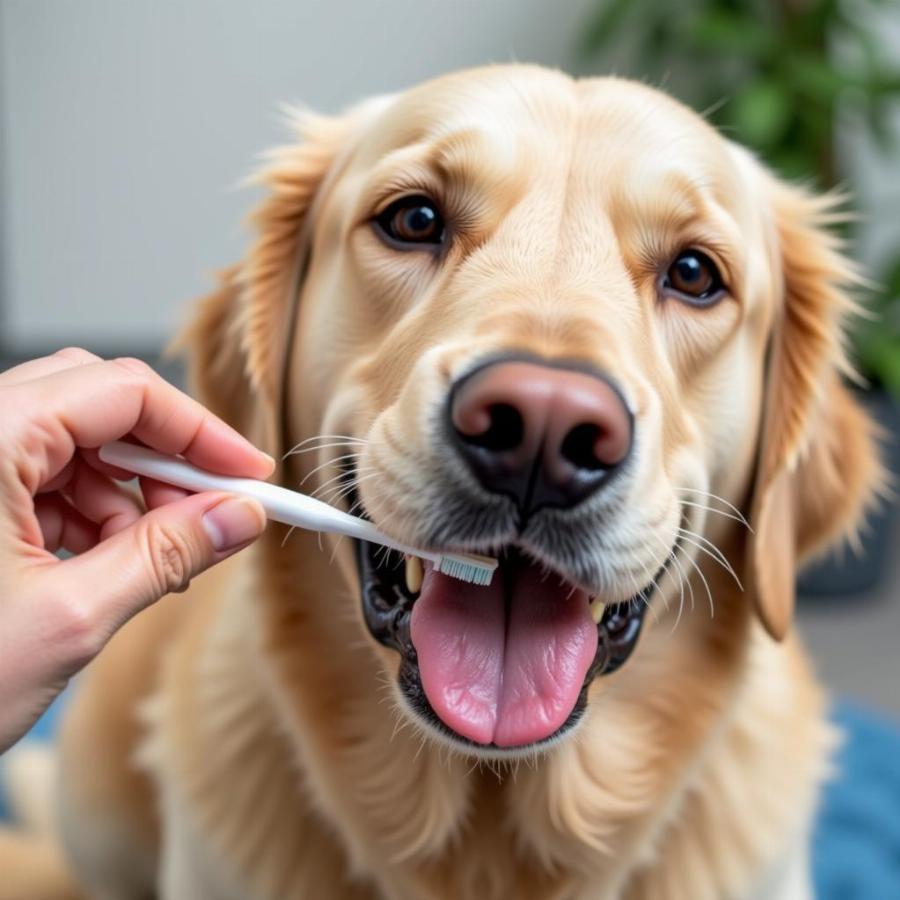Taking care of your furry friend’s dental hygiene is just as important as their diet and exercise. While it might seem like a small detail, dog brushing teeth is crucial for preventing dental disease, bad breath, and other health issues. This comprehensive guide will cover everything you need to know about keeping your canine companion’s pearly whites sparkling clean.
Why is Dog Brushing Teeth so Important?
Just like humans, dogs can develop plaque and tartar buildup on their teeth, leading to a whole host of problems.
- Bad Breath: Let’s face it, doggy breath is a thing, but persistent bad breath can be a sign of dental disease.
- Gum Disease: Plaque and tartar irritate the gums, leading to gingivitis (inflammation) and potentially periodontitis, a more serious infection.
- Tooth Loss: In severe cases, untreated dental disease can lead to painful tooth loss.
- Organ Damage: Bacteria from dental disease can enter the bloodstream and potentially affect your dog’s heart, liver, and kidneys.
 Dog Brushing Routine
Dog Brushing Routine
How Often Should You Brush Your Dog’s Teeth?
Ideally, you should aim to brush your dog’s teeth daily. We understand that life gets busy, but even brushing a few times a week can make a big difference.
What You’ll Need for Dog Brushing Teeth
- Dog Toothpaste: Never use human toothpaste, as it contains ingredients that can be harmful to dogs. Look for enzymatic toothpaste specifically designed for canines. They come in tasty flavors like chicken and peanut butter, making the experience more enjoyable for your pup!
- Dog Toothbrush: Choose a toothbrush with soft bristles and a size appropriate for your dog’s mouth. You can find finger brushes, dual-ended brushes, or even toothbrushes that fit on your finger for easier access.
- Patience and Positive Reinforcement: Approach teeth brushing with patience and positivity. Make it a fun and rewarding experience for your dog by offering praise, treats, and belly rubs!
Step-by-Step Guide to Brushing Your Dog’s Teeth
- Introduce Brushing Gradually: Don’t rush the process! Start by getting your dog used to having their mouth touched. Gently massage their gums and teeth with your finger.
- Introduce the Toothpaste: Let your dog lick a small amount of dog toothpaste off your finger so they associate it with something positive.
- Introduce the Toothbrush: Gradually introduce the toothbrush, allowing your dog to sniff and lick it.
- Start Brushing: Hold the brush at a 45-degree angle to the gum line and use gentle, circular motions. Focus on the outer surfaces of the teeth where plaque tends to accumulate most.
- Keep it Short and Sweet: Start with short sessions (about 30 seconds) and gradually increase the time as your dog gets more comfortable.
Additional Tips for Dog Dental Care
- Dental Chews and Treats: Offer your dog dental chews and treats approved by the Veterinary Oral Health Council (VOHC). These can help reduce plaque and tartar buildup.
- Dental Diets: Some dog food brands offer dental-specific formulas that help clean teeth as your dog chews.
- Regular Veterinary Checkups: Schedule professional dental cleanings with your veterinarian as recommended. They can remove plaque and tartar that you can’t reach at home.
When to See a Vet
If you notice any of the following signs, consult your veterinarian immediately:
- Excessive drooling
- Bleeding gums
- Loose teeth
- Difficulty eating
- Pawing at the mouth
- Swelling around the mouth
Frequently Asked Questions about Dog Brushing Teeth
Q: Can I use baking soda to brush my dog’s teeth?
A: While baking soda has some mild abrasive properties, it’s not recommended for dog brushing teeth. It doesn’t contain the enzymes needed to break down plaque and can be harmful if swallowed in large amounts.
Q: My dog refuses to let me brush their teeth. What should I do?
A: Don’t worry! Some dogs need more time and patience to adjust to teeth brushing. Try different techniques like using a finger brush or offering high-value treats. If you’re still struggling, consult your veterinarian or a certified dog trainer for advice.
Q: How do I know if my dog has dental disease?
A: Bad breath is often the first sign, followed by yellow or brown tartar buildup on the teeth, red or swollen gums, and changes in eating habits.
Don’t Wait, Start Brushing!
Taking care of your dog’s teeth doesn’t have to be a chore. By incorporating dog brushing teeth into your routine and using the tips provided, you can help your furry friend maintain a healthy smile and fresh breath for years to come.
Need More Help with Your Dog’s Dental Care?
Beaut Dogs is here to support you every step of the way. For personalized advice and answers to your dog dental care questions, contact our experts at [email protected]. We’re passionate about helping you keep your canine companion happy and healthy!